Poor Lady Jane Grey; fourth-in-line to the throne at the time of Edward VI’s coronation but Queen of England upon his death. The Nine Day Queen was never someone who wanted the throne in the way that she got it. On May 21, 1553, she was married to Guildford Dudley, the fourth son of Edward VI’s Lord Protector, John Dudley. While this marriage was not in her parents’ best interests, it was in his and it set up the downfall of the Dudley-Grey line.

Jane Grey and Guildford Dudley Marry Setting Up the Events of Their Downfalls
On May 21, 1533, Lady Jane Grey and Guildford Dudley married. This set up the plot for John Dudley's family to take the throne, although it didn't quite go to plan.
John Dudley Convinces Edward VI to Change the Line of Succession
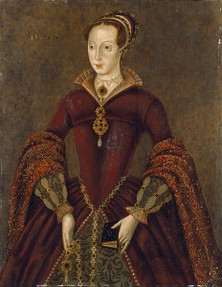 By May 1553, Edward VI was a sickly King. It seemed like he didn’t have much longer to live and John Dudley had to act quickly. They all knew that Lady Mary Tudor was next in line to the throne and would have caused problems for the religious reformation. Edward VI was a Protestant and wanted that religion to continue, while his half-sister wanted to return the country to the way that it once was.
By May 1553, Edward VI was a sickly King. It seemed like he didn’t have much longer to live and John Dudley had to act quickly. They all knew that Lady Mary Tudor was next in line to the throne and would have caused problems for the religious reformation. Edward VI was a Protestant and wanted that religion to continue, while his half-sister wanted to return the country to the way that it once was.
John Dudley found a way around that and to gain more power. By John’s son marrying Jane, his son could become King of England. He just had to convince Edward to change the line of succession. This wasn’t actually that difficult, as it is possible that Edward VI was looking for this already. Dudley used the excuse that both Mary and Elizabeth were illegitimate – they had no real claim to the throne.
The next problem was the fact that Frances Brandon, Edward’s cousin, was the next in line. Edward VI’s will passed over Frances, outraging her and her husband, Henry Grey. Edward spoke to her and explained the situation and Frances agreed to allow the crown to pass her, onto her eldest daughter, Jane.
Lady Jane Grey Becomes Queen Regent
Jane was pronounced Queen on July 10, 1553. Jane was not prepared for this and it seemed that nobody had told her about the plan. Jane believed that Mary would be the Queen and wanted the line of succession to remain that way. She accepted the throne but that acceptance was reluctance.
John Dudley’s plan didn’t quite work out how he wanted it to. Jane refused to name her husband as King and, instead, offered to make him a Duke. The next part of John’s plan didn’t work out either.
John needed to capture the Lady Mary and set up a trap. However, when Mary heard of the new Queen Regent, she built up the support of the people of England. They wanted Mary as Queen, even the Protestant factions, as she was favoured due to her mother’s memory. The people of England were never to know how the next five years would turn out. Dudley failed to capture her and this led to the fall of Queen Jane.
The Privy Council Favour Lady Mary Tudor
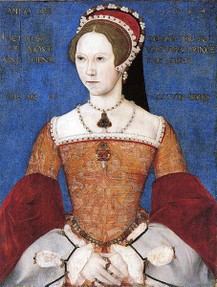 While Dudley tried to capture Lady Mary, the Privy Council changed their allegiance. They knew the people of England wanted Mary, who had a stronger claim to the throne due to Henry VIII’s will. Jane was arrested on July 19 and Mary Tudor declared Queen. Dudley was arrested and executed in August 1553. However, Jane and her husband were not originally going to be executed. While they were charged with high treason and were found guilty on November 13, 1533, they were not executed immediately.
While Dudley tried to capture Lady Mary, the Privy Council changed their allegiance. They knew the people of England wanted Mary, who had a stronger claim to the throne due to Henry VIII’s will. Jane was arrested on July 19 and Mary Tudor declared Queen. Dudley was arrested and executed in August 1553. However, Jane and her husband were not originally going to be executed. While they were charged with high treason and were found guilty on November 13, 1533, they were not executed immediately.
It is possible that Mary realised that Jane was innocent. The problem was that she had signed her name as Jane, the Queen, on documents, which supported the evidence for treason. Mary decided that her life would be spared but she would spend it in The Tower.
Lady Jane Grey Finally Executed for Her Father's Actions
In January 1554, Thomas Wyatt the Younger led a protestant rebellion against Mary. This was at the time that Mary was planning to marry Philip II of Spain and the protestants feared how this marriage would turn the country back into a Catholic one. Unfortunate for Jane, her father and two uncles joined with the rebellion.
These actions sealed the fates of Jane and her husband. The government and Mary decided that it was time to execute the two, which was scheduled for February 9, 1554. Mary opted to postpone the execution for three days to give Jane the opportunity to convert from the Lutheran to the Catholic faith.
Jane refused to convert but she did become friends with John Feckenham, Mary’s chaplain. Feckenham helped Jane to the scaffold on her execution date.
How Much Do You Know About Mary I?
 |  |  |
| The Myth of "Bloody Mary": A Biograph... | This Bloody Mary: Is the Last Thing I... | Mary, Bloody Mary |
The Executions of Jane Grey and Guildford Dudley
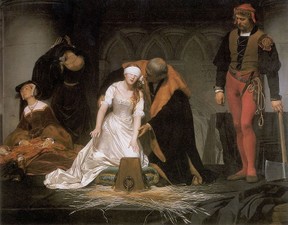 Guildford was the first to be executed on February 12 on Tower Hill. His body would have been taken past Jane’s rooms and she would have been able to see her body. She was then taken to Tower Green, where her execution too place. Jane’s execution was blindfolded, which caused problems when finding the block.
Guildford was the first to be executed on February 12 on Tower Hill. His body would have been taken past Jane’s rooms and she would have been able to see her body. She was then taken to Tower Green, where her execution too place. Jane’s execution was blindfolded, which caused problems when finding the block.
She cried out, “What shall I do? Where is it?” as she panicked about where the block was to lay her head. Deputy Lieutenant of the Tower, Thomas Brydges, helped her to the block where she was executed easily. Her father was executed 11 days later but her mother’s life, despite all the scheming in Jane’s past, was sparred.
Jane’s family were removed from the line of succession and replaced with the Scottish cousins since the Grey name had been tainted, despite Henry VIII’s wishes to keep the English throne out of the Scottish’s hands. However, Frances Brandon, Jane’s mother, was given a pardon by the Queen, along with Jane’s two surviving sisters.
You might also like
England Under the Tudors: Would King Edward VI Have Been a Goo...Edward VI reigned between 1547 and 1553 when he was just a boy. It's hard to ...
Lady Jane Boleyn: Vindictive Woman or Pawn in a Plot?Jane Boleyn is known for her part in bringing down the Boleyn faction. How mu...
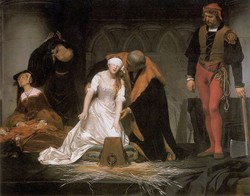





 Alternate History: What If Mary I Had a Child?on 01/26/2015
Alternate History: What If Mary I Had a Child?on 01/26/2015
 Francis II of France Dies: Mary, Queen of Scots Returns Homeon 12/05/2014
Francis II of France Dies: Mary, Queen of Scots Returns Homeon 12/05/2014
 Does Writedge Pay? Payment Proofon 12/03/2014
Does Writedge Pay? Payment Proofon 12/03/2014
 Alternate History: What If Lady Jane Grey Was Not Deposed?on 11/11/2014
Alternate History: What If Lady Jane Grey Was Not Deposed?on 11/11/2014
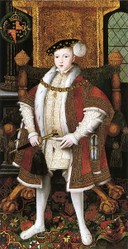
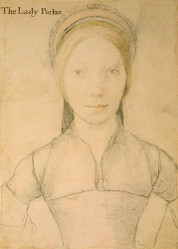
Comments